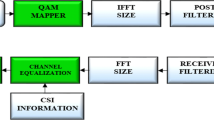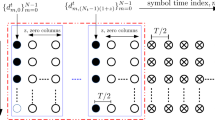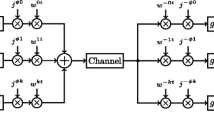Abstract
This paper deals with the equalization of rectilinear and quasi-rectilinear modulated signals over frequency selective channels. This study is motivated by the fact that offset quadrature amplitude modulation based filter bank multi-carrier, one of the most prominent post orthogonal frequency division multiplexing contenders for beyond 5G wireless communication systems, employs offset quadrature modulation. This modulation is known to be cyclo-stationary and non-second order circular. Three minimum mean squared error based equalizing structures have been developed, referred to as linear (LE), widely linear (WLE) and widely linear Fresh (WL Fresh) equalizers. For the proposed equalizers, both symbol spaced and fractionally spaced processing have been evaluated, in synchronous DL/UL and asynchronous UL scenarios, with mixed numerologies transmissions. The simulation results show the ability of WL Fresh equalizer to suppress inter-numerology and inter-symbol interferences over frequency selective channels, outperforming the WLE and LE equalization schemes.













Similar content being viewed by others
References
5g and beyond waveforms. (May 2017). In 2017 24th international conference on telecommunications (ICT) (pp. 1–42).
Ankarali, Z. E., Peköz, B., & Arslan, H. (2017). Flexible radio access beyond 5g: A future projection on waveform, numerology, and frame design principles. IEEE Access, 5, 18295–18309.
Qualcomm Inc. (April 2016). Waveform requirements. In 3GPP Standard Contribution (R1-162198).
Demir, A. F., Elkourdi, M., Ibrahim, M., & Arslan, H. (2019). Waveform design for 5g and beyond. arXiv preprint arXiv:1902.05999.
Elkourdi, M., Peköz, B., Güvenkaya, E., & Arslan, H. (April 2016). Waveform design principles for 5g and beyond. In 2016 IEEE 17th annual wireless and microwave technology conference (WAMICON) (pp. 1–6).
Qualcomm Technologies. (2015). Waveform requirements.
Huawei, HiSilicon. (April 2016). 5g waveform: requirements and design principles. In 3GPP Standard Contribution (R1-162151).
Zhang, X., Zhang, L., Xiao, P., Ma, D., Wei, J., & Xin, Y. (2018). Mixed numerologies interference analysis and inter-numerology interference cancellation for windowed ofdm systems. IEEE Transactions on Vehicular Technology, 67(8), 7047–7061.
Bellanger, M. (Jan 2010). Physical layer for future broadband radio systems. In 2010 IEEE radio and wireless symposium (RWS) (pp. 436–439).
Fhima, H., Chang, B. S., Zayani, R., Shaiek, H., Roviras, D., & Bouallegue, R. (June 2018). Performance of linear and widely linear equalizers for fbmc/oqam modulation. In 2018 25th international conference on telecommunications (ICT) (pp. 605–609).
Medjahdi, Y., Terre, M., Le Ruyet, D., Roviras, D., Nossek, J. A., & Baltar, L. (June 2009). Inter-cell interference analysis for ofdm/fbmc systems. In 2009 IEEE 10th workshop on signal processing advances in wireless communications (pp. 598–602).
Zayani, R., Medjahdi, Y., Shaiek, H., & Roviras, D. (Dec 2016). Wola-ofdm: A potential candidate for asynchronous 5g. In IEEE Globecom Workshops (GC Wkshps) (pp. 1–5).
Zayani, R., Shaiek, H., Cheng, X., Fu, X., Alexandre, C., & Roviras, D. (2018). Experimental testbed of post-ofdm waveforms toward future wireless networks. IEEE Access, 6, 67665–67680.
Nimr, A., Chafii, M., Matthé, Ma., & Fettweis, G. (2018). Extended gfdm framework: Otfs and gfdm comparison. In 2018 IEEE global communications conference (GLOBECOM) (pp. 1–6). IEEE.
Towliat, M., & Asgari Tabatabaee, S. M. J. (2018). Gfdm interference mitigation without noise enhancement. IEEE Communications Letters, 22(5), 1042–1045.
Chen, H., Hua, J., Li, F., Chen, F., & Wang, D. (2019). Interference analysis in the asynchronous f-ofdm systems. In IEEE Transactions on Communications (pp. 1–1).
Chevalier, P., & Pipon, F. (2006). New insights into optimal widely linear array receivers for the demodulation of bpsk, msk, and gmsk signals corrupted by noncircular interferences-application to saic. IEEE Transactions on Signal Processing, 54(3), 870–883.
Fhima, H., Zayani, R., Shaïek, H., Roviras, D., Chang, B. S., & Bouallegue. R. (July 2017). Widely linear equalizer performance with multiple independent interferences. In 2017 IEEE symposium on computers and communications (ISCC) (pp. 912–917).
Gerstacker, H., Schober, R., & Lampe, A. (2003). Receivers with widely linear processing for frequency-selective channels. IEEE Transactions on Communications, 51(9), 1512–1523.
Fhima, H., Shaïek, H., Zayani, R., Roviras, D., Chang, B. S., & Bouallegue, R. (Oct 2018). Analysis of widely linear equalization over frequency selective channels with multiple interferences. In 2018 14th international conference on wireless and mobile computing, networking and communications (WiMob) (pp. 83–88).
Dayana, R., & Kumar, R. (May 2016). Co-operative cyclo-stationary feature detection with universal filtered multi-carrier spectrum sensing for cognitive radio network. In 2016 IEEE international conference on recent trends in electronics, information communication technology (RTEICT) (pp. 1647–1650).
Lazov, V., & Vandersteen, G. (May 2016). Cyclo-stationary process analysis within telecom applications. In 2016 IEEE international instrumentation and measurement technology conference proceedings (pp. 1–6).
Chevalier, P., Delmas, J., & Chauvat, R. (July 2016). Reception filter impact on widely linear fresh receiver performance for saic/maic with frequency offsets. In 2016 IEEE sensor array and multichannel signal processing workshop (SAM) (pp. 1–5).
Chauvat, R., Chevalier, P., & Delmas, J. (Aug 2015). Widely linear fresh receiver for saic/maic with frequency offsets. In 2015 International symposium on wireless communication systems (ISWCS) (pp. 536–540).
Elgenedy, M., Sayed, M., Al-Dhahir, N., & Chabaan, R. C. (2018). Cyclostationary noise mitigation for simo powerline communications. IEEE Access, 6, 5460–5484.
Ikhlef, A., & Louveaux, J. (June 2009). An enhanced mmse per subchannel equalizer for highly frequency selective channels for fbmc/oqam systems. In 2009 IEEE 10th Workshop on signal processing advances in wireless communications (pp. 186–190).
Levanen, T., Pirskanen, J., Pajukoski, K., Renfors, M., & Valkama, M. (2019). Transparent tx and rx waveform processing for 5g new radio mobile communications. IEEE Wireless Communications, 26(1), 128–136.
Zaidi, A. A., Baldemair, R., Tullberg, H., Bjorkegren, H., Sundstrom, L., Medbo, J., et al. (2016). Waveform and numerology to support 5g services and requirements. IEEE Communications Magazine, 54(11), 90–98.
Shaiek, H., Zayani, R., Medjahdi, Y., & Roviras, D. (2019). Analytical analysis of ser for beyond 5g post-ofdm waveforms in presence of high power amplifiers. IEEE Access, 7, 29441–29452.
Suleiman, W., Parvazi, P., Pesavento, M., & Zoubir, A. M. (2018). Non-coherent direction-of-arrival estimation using partly calibrated arrays. IEEE Transactions on Signal Processing, 66(21), 5776–5788.
Wielgus, A., Magiera, W., & Smagowski, P. (Nov 2018). Efficiency of the multidimensional schur-type estimation algorithms for higher-order stochastic processes. In 2018 IEEE 23rd international conference on digital signal processing (DSP) (pp. 1–5).
Wielgus, A., Magiera, W., & Smagowski, P. (Sep. 2018). Efficiency of the nonlinear schur-type estimation algorithms for higher-order stochastic processes. In 2018 International conference on signals and electronic systems (ICSES) (pp. 172–176).
Picinbono, B., & Chevalier, P. (1995). Widely linear estimation with complex data. IEEE Transactions on Signal Processing, 43(8), 2030–2033.
Gardner, W. A. (1993). Cyclic wiener filtering: Theory and method. IEEE Transactions on Communications, 41(1), 151–163.
Hunger, R. (2005). Floating point operations in matrix-vector calculus. Munich University of Technology, Inst. for Circuit Theory and Signal Processing.
Acknowledgements
This work was supported by the WONG5 Project from the French National Agency (ANR) under Contract ANR-15-CE25-0005-02.
Author information
Authors and Affiliations
Corresponding author
Additional information
Publisher's Note
Springer Nature remains neutral with regard to jurisdictional claims in published maps and institutional affiliations.
Rights and permissions
About this article
Cite this article
Fhima, H., Zayani, R., Shaïek, H. et al. Comparison of Linear, Widely Linear and Fresh Equalizers for FBMC-OQAM Systems with Different Numerologies. Wireless Pers Commun 115, 1137–1160 (2020). https://doi.org/10.1007/s11277-020-07615-5
Published:
Issue Date:
DOI: https://doi.org/10.1007/s11277-020-07615-5




